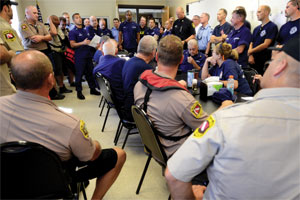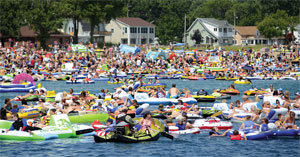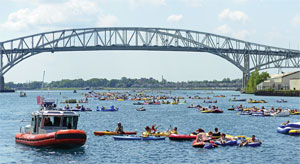In an unusually public and blunt campaign, Great Lakes shipowners have taken aim at a recreational event they say is dangerous and inhibits waterborne commerce at the height of their busiest season.
A petition from maritime operators asking the public to boycott Michigan’s Port Huron Float Down didn’t curtail the long-held tradition, but it may have prompted some positive change.
A week before the 2015 event was scheduled to take place on Aug. 16, the Lake Carriers’ Association and the Canadian Shipowners Association released a joint statement urging the public to not participate in the unsanctioned event, citing safety concerns and a negative impact on commercial navigation.
The plea follows the 2014 death of a 19-year-old man who drowned during the Float Down.
“The Port Huron Float Down is neither carefully planned nor adequately supervised, and when coupled with the expected consumption of alcohol, this is an invitation to disaster,” Lake Carriers’ Association President James H.I. Weakley said in the statement. “The fast-running and chilly waters of the St. Clair River between Port Huron and Marysville are a federal navigation channel, not a playground.”
 |
|
Officers from a variety of law-enforcement agencies gather at the U.S. Coast Guard station in Port Huron, Mich., for a briefing at the start of the 2015 Float Down. |
|
Courtesy U.S. Coast Guard |
Thousands of people each year man inflatable rafts for the seven-mile float. This year’s attendance was estimated at 5,000. Although there had been past attempts by the U.S. Coast Guard to halt the event, it continues — unofficially — each year, and has prompted the Coast Guard to secure the waterway.
Strong river currents, low water temperatures, the large number of participants and, often, the consumption of alcohol, can make the Port Huron Float Down dangerous and challenging for first responders. Last year, agencies assisted nearly 120 participants who were in danger of drowning, getting caught on dangerous obstructions or drifting into the navigable channel, according to the Coast Guard. Preliminary reports indicate more than 285 people were assisted this year, with 150 becoming separated from their group and approximately 1,850 needing assistance back across the border after the wind blew them into Canadian waters. Seven people received emergency medical services and four were transported to the hospital.
Industry leaders insist their biggest concern is for the participants’ safety. Secondarily, though, the event throws a wrench into commercial operations, particularly because it’s unsanctioned and, therefore, unpredictable.
“When we understand an event, we have the ability to plan for it,” said Robert Lewis-Manning, president of the Canadian Shipowners Association. “That does mitigate some of the cost to the shipowners and customers.”
But without an organization or coordinator to work with, which exists for something like Ohio’s Head of the Cuyahoga race and other sanctioned events, planning isn’t always guaranteed to go smoothly.
 |
|
The Aug. 16 event attracted thousands of participants, many in inflatable rafts. One person drowned at the 2014 gathering, and authorities increasingly need to monitor the floaters closely because some can become stranded in the river or illegally cross the Canadian boundary. |
|
Courtesy U.S. Coast Guard |
It can mean either advancing or delaying your planned sailings and taking the risk that there isn’t enough dock space to accommodate your ship when it arrives, Lewis-Manning said. When unexpected events like this happen, the cost can add up.
Lewis-Manning speculated that operating costs could amount to hundreds of thousands of dollars. This is in addition to policing by the U.S. and Canadian coast guards and other agencies, at a cost of approximately $100,000 annually, said Lake Carriers’ Association Vice President Glen G. Nekvasil.
The boycott call wasn’t entirely in vain. The Coast Guard enacted and enforced a temporary regulation to ensure everyone under the age of 18 was wearing personal flotation devices, and noted more children were seen wearing them this year than in years past.
“Hopefully, this has started a dialogue that will lead to a positive result,” said Lewis-Manning.

